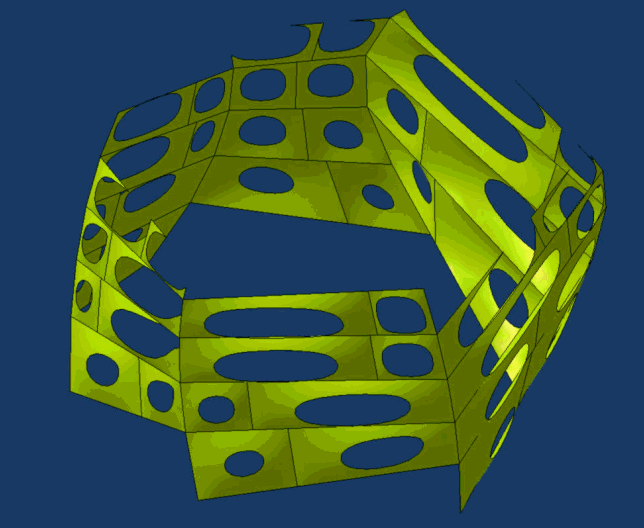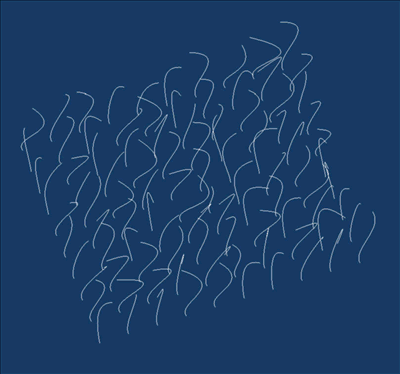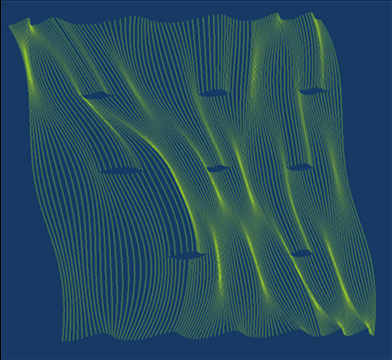
Wednesday, December 24, 2008
Knowledgeware Optimization

Sunday, November 30, 2008
Random Numbers for Framework
Click the image to get to the streaming video.

Saturday, November 15, 2008
Generating Drawings
Tuesday, November 11, 2008
Framework Options
 . Click the image to start the video.
. Click the image to start the video.
Thursday, November 6, 2008
Fire Installed

John and I finished the installation of the Fire project and the the opening occured last night. Once I get a chance to photograph it I will upload more. For now, here are some i-phone shots.
There is more up on John's blog: http://designedobjects.blogspot.com/.
And some images from the opening from Earl Carlson: http://www.theearlcarlson.com/duderstadt/fire.html
'Fire' from John Marshall on Vimeo.
Sunday, October 26, 2008
Unfolded PowerCopy
Arts & the Environment: FIRE
The opening night of the installations / performances is on: November 5 from 5 - 11.
Here is a link to Arts & the Environment.
A series of aluminum forms will hold an array of autonomous interactive units that will respond to the movement and environmental conditions around it. The behavior is obviously informed by the dynamic qualities of fire.





Saturday, October 18, 2008
Random Numbers linked from Excel
Here is a link to the video.

Saturday, October 4, 2008
Grasshopper - Brick Surface
Here is the grasshopper file.

Thursday, October 2, 2008
Grasshopper - Array of Boxes
Beyond the simple re-orientation the file uses both a MAX and MIN to control the size of the boxes.
Click the image to watch the video.
Here is a link to the grasshopper file.

Digital Project - Tutorial 5 - Document Templates
Document templates allow for advanced replicatiopn at the product level, each part of the syetem is a separate file.
Click the image below to view the 40 minute streaming video.

Tuesday, September 23, 2008
Digital Project - Tutorial 4 - Power Copies

Thursday, September 18, 2008
Digital Project - Tutorial 3 - Part to Whole
Wednesday, September 10, 2008
Digital Project - Tutorial 2 - Surfaces
It is 65 minutes long and builds on tutorial 1. Here we will use the first sketch to drive the height and shape of the covering surface. At this point the form is less of a concern than learning how to develop the interactions.
Click the image below to go to the streaming video. I am still working on the best format / size/ player for the tutorials. This one is a bit large and takes a minute to load.

Monday, September 1, 2008
Digital Project - Tutorial 1 - The Sketch

ParaMod Seminar: Structural Density
The plan is to post samples of the student work to share the research. A series of video tutorials will be developed to support the seminar work. I will be posting these tutorials here too.
Here is a link to the syllabus for the seminar.


Sunday, August 17, 2008
Parametric Wooden Strips
 A series of conical forms are used to control the radii of the wood strips. The more extreme the cone, the more open the gap in the strips.
A series of conical forms are used to control the radii of the wood strips. The more extreme the cone, the more open the gap in the strips. A simple Catia diagram demonstrates the relationship between the cones and the strips. The parametric model allows for quick feedback between the manipulation of cone and the redulting affect of the strips and gaps.
A simple Catia diagram demonstrates the relationship between the cones and the strips. The parametric model allows for quick feedback between the manipulation of cone and the redulting affect of the strips and gaps. Here is a link to a video of the Catia file.
Here is a link to a video of the Catia file.
Back from traveling

We saw some amazing projects. The architects were all very open and interested in talking about similarities and differences between architecture and practice. The most striking difference is the role of labor. In Argentina the labor is less expensive but the materials are more expensive in comparison to the US. As a result, the use of brick and concrete (cheap materials) is more widespread and of much higher quality. The craft and time taken to build with masonry or fabricate on-site formwork is not a fearful proposition as it is in the US.


Waiting for our table. With Gerardo, Marcelo, Luis, Juan, Craig, and Jen.

And the steak... We ate some very good Argentinian beef while drinking very good wine from Mendoza.
Sunday, July 20, 2008
Spiral Revisited
 The goal for this project was to have the first few points lay flat before changing elevation. The thought was this would give it a stable base.
The goal for this project was to have the first few points lay flat before changing elevation. The thought was this would give it a stable base.
 Projecting the shape flat then allows for the creation of the "V" column at the termination of the spiral. A split, subset, and interval are used to create spokes between different parts of the spiral.
Projecting the shape flat then allows for the creation of the "V" column at the termination of the spiral. A split, subset, and interval are used to create spokes between different parts of the spiral.

Here is a link to the grasshopper file.
Sunday, July 13, 2008
Intro Rhino Tutorial 005 - Output: Maxwell Render

This tutorial takes the model from the previous tutorial and creates a simple exterior rendering. A sky and people are added with a couple of simple tricks in photoshop.
 Here is a link to the 25 minute video tutorial.
Here is a link to the 25 minute video tutorial.
Saturday, July 12, 2008
Spiral Structure - Grasshopper
 While it is very easy to make a spiral with an equation, I took the approach to make a series of points that build (and translate) from the previous point. Once a series of 10 points have been created, an interpolate curve connects them and then these curves make surfaces. Dividing the curves a series of pipes connect points to form an in between structure.
While it is very easy to make a spiral with an equation, I took the approach to make a series of points that build (and translate) from the previous point. Once a series of 10 points have been created, an interpolate curve connects them and then these curves make surfaces. Dividing the curves a series of pipes connect points to form an in between structure. As more rotation occurs between points, the curve must interpolate, creating oblong cuves.
As more rotation occurs between points, the curve must interpolate, creating oblong cuves. While the file is not as elegant as I would like, the file includes shift and interval as a way to connect the various divide points. If anyone has a better idea how to repeat the multiple actions of the spiral, I would be open to hearing about it. As far as I know there is no loop function which would do the trick.
While the file is not as elegant as I would like, the file includes shift and interval as a way to connect the various divide points. If anyone has a better idea how to repeat the multiple actions of the spiral, I would be open to hearing about it. As far as I know there is no loop function which would do the trick.
Download the grasshopper file here .
Tuesday, July 8, 2008
Rhino Tutorial Output: Vectors
Here is a link to the 40 minute video.
Sunday, July 6, 2008
Illuminated Surface
 Two splines are used to control a series of surfaces and the toolpaths used to mill the surface.
Two splines are used to control a series of surfaces and the toolpaths used to mill the surface.
Here are the lines overlaid on the surfaces. At various points the surface splits to allow a small aperature to move from behind. The various iterations of the line drawings are made through the movement of the two splines. Digital Project was used to define the relationships and only after everything was worked out, the splines were modified to approximate the final proportions of the splines and aperatures.
The two renderings show the light from behind as trapped between the two surfaces. The final piece will be milled from plywood.
This series of models is more of a proof of concept for the aperatures. A new model will be developed using the splines, but using a different method to create a model with thickness. The current iteration is only one surface.

Saturday, June 28, 2008
Rhino Tutorial 003
Here is a link to the 45 minute tutorial video.
Rhino Tutorial 002
Here is a link to the tutorial video.
Friday, June 27, 2008
Rhino Tutorial 001
Here is a link to the tutorial.

Thursday, June 26, 2008
Digital Project Honeycombs
 Then as the individual cell is made larger or smaller than the average size, it is made deep/shallow or thick/think. This variation is visible in the iterations below. This level of analysis adds a level of removal from the designer. One cannot be sure where the depth will shift.
Then as the individual cell is made larger or smaller than the average size, it is made deep/shallow or thick/think. This variation is visible in the iterations below. This level of analysis adds a level of removal from the designer. One cannot be sure where the depth will shift.  Variations are rendered to give some sense of the range of variation possible. I will be gearing up for class in the fall and will post tutorials on document templates and rule firing, check back.
Variations are rendered to give some sense of the range of variation possible. I will be gearing up for class in the fall and will post tutorials on document templates and rule firing, check back.Monday, June 23, 2008
Point Distance Surface
Making a few tweeks with the sliders and then baking each, the variations from a screen shot below. Unfortunately I could not find a way to trim in grasshopper so this task is completed once the geometry is baked.


Revised file based on some feedback from Gabe. My trim is a bit messy because I could not get it to subtract the correct side. I exploded the surfaces to get the final trim. Here is a link to the grasshopper file.







